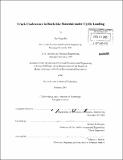Crack coalescence in rock-like material under cycling loading
Author(s)
Ko, Tae Young, 1973-
DownloadFull printable version (31.29Mb)
Other Contributors
Massachusetts Institute of Technology. Dept. of Civil and Environmental Engineering.
Advisor
Herbert H. Einstein.
Terms of use
Metadata
Show full item recordAbstract
A total of 170 tests (68 tests for monotonic loading, 102 tests for cyclic loading) have been performed to investigate crack initiation, propagation and coalescence. The specimens have two pre-existing flaws which are arranged at different distances and angles. Wing cracks and secondary cracks are observed in both monotonic and cyclic tests. Wing cracks, which are tension cracks, initiate at (or near) the tips of the flaws and propagate parallel to the compressive loading axis. Secondary cracks always appear after wing crack initiation and lead to final failure. Secondary cracks initiate at the tips of the flaws and propagate in the coplanar direction of the flaw or horizontal (quasi-coplanar) direction. Six types of coalescence are observed. For coplanar geometry specimens, coalescence occurs due to the internal shear cracks. For non-coplanar geometry specimens, coalescence occurs through combinations of internal shear cracks, internal wing cracks and tension cracks. Contrary to monotonic tests, cyclic tests produce fatigue cracks. Fatigue cracks usually occur when 1) after coalescence, the specimens behave as if they had only one larger crack 2) specimens have been subjected to a particular number of cycles. In these experiments, two different fatigue crack initiation directions are observed: horizontal and coplanar to the flaw.
Description
Thesis (Civ. E.)--Massachusetts Institute of Technology, Dept. of Civil and Environmental Engineering, 2005. Includes bibliographical references (p. 181-184).
Date issued
2005Department
Massachusetts Institute of Technology. Department of Civil and Environmental EngineeringPublisher
Massachusetts Institute of Technology
Keywords
Civil and Environmental Engineering.